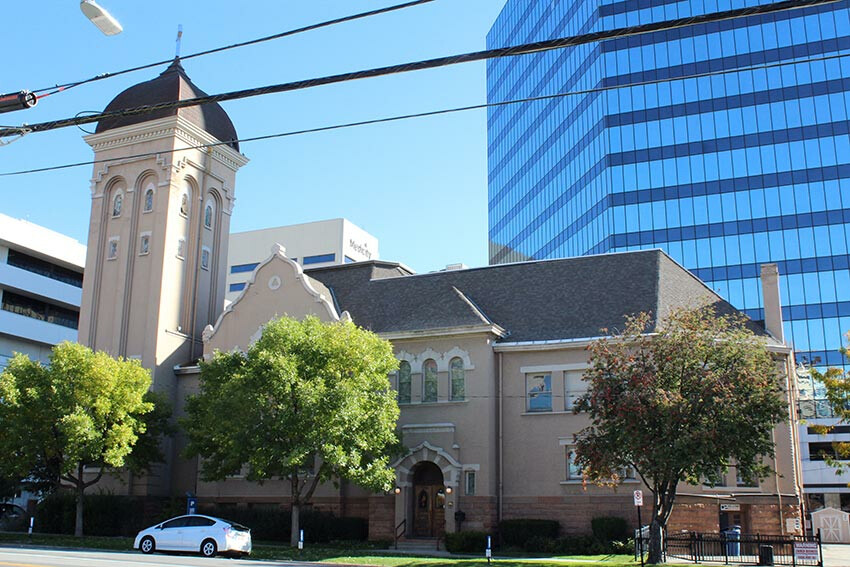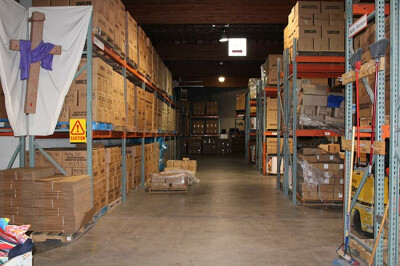Traveling the Circuit: Gems in the Heart of the Old West
By Rev. Charles Harrell

Where can the United Methodist traveler find a building that’s
The year was 1869. The famous golden spike was still warm from being struck in May of that year to complete the first transcontinental railroad that May at Promontory Summit, some 60-odd miles distant, when Rev. Lewis Hartsough disembarked in December at Salt Lake City, then the new capital of Utah Territory. Preaching his first sermon in the hopefully-named “Independence Hall” – in reality, a simple adobe structure set aside by Governor Brigham Young for “gentile” (i.e., non-Mormon) groups to hold worship – Rev. Hartsough set about organizing a Methodist meeting. Before long, the first regular pastor was appointed to oversee both a congregation and an educational ministry that would multiply itself in towns around the territory. In 1870, the first truly Methodist meeting site was secured: a loft over a livery barn. It wasn’t elegant – and the $50 weekly rent was sky-high for the time – “an exorbitant amount, but our only chance,” in the opinion of the first pastor, Rev. Gustavus Peirce.
But just as in the first days of Methodism, from tiny starts, God made great things grow. By 1875, a neo-Gothic church building had been constructed for the flourishing First Methodist Episcopal Church and its education work. Before long, the teaching ministry had overflowed to include a Deaconess Home, which is still owned by the Women’s Division and operates today as the Crossroad Urban Center (at 300 S 400 East). Even so, by the turn of the 20th century, First M.E. Church was outgrowing its building once more.
So in
The crown jewel of the building, however, is not its sanctuary, or its bold tower, or the richly-toned woodwork in fir from the nearby Ochre Mountains, or even the 1500-piece painted-glass mosaic from Belgium along one wall. It is, instead, the organ, whose technical aspects a music geek will love but whose story is compelling even for those who prefer more contemporary instruments.
Built by George H. Ryder and originally situated in the previous First Church building, it was moved to the present site in
I had the privilege of spending a couple of hours with Mike Green, First Church’s historian and an unfailing fount of knowledge about the church, who told of the many “gifts upon gifts” from God that made the restoration happen. He described the impossible price tag for restoring the stenciling, thought to be insurmountable until they “happened” to find the one expert in the region who could not only do the
Indeed, the organ project has been a model of community and interfaith support, as well, with generous gifts from the LDS Church (many of First’s organists having also played for the Mormon Tabernacle), the local Roman Catholic diocese, the Episcopal cathedral in Salt Lake, as well as banks and businesses. In turn, First Church is actively forging ties of welcome and engagement with Salt Lake’s growing musical and artistic community as part of its outreach and hospitality.
Perhaps the most prominent couple to belong to First Church were James Cash (J.C.) Penney and his wife, Berta Alva Hess Penney. Fresh from establishing a successful chain called the “Golden Rule” stores in Wyoming, Penney moved with his family to Salt Lake to make it the base of his new J.C. Penney Company. The family attended First Church, though at first only Berta formally joined. In 1910, she died suddenly from complications after surgery. J.C., devastated, found help through his grief from by Dr. Francis Short, the pastor of First Church at the time. As an expression of gratitude, Penney paid off the remaining debt on the church’s new building in 1912. Penney’s company would move to New York shortly thereafter, but a plaque in memory of Berta Penney graces the church’s tower.
There is, however, much more to First Church Salt Lake than its building or storied history. First UMC is a leading participant in Community Promise, a consortium of nine churches that rotate providing year-round shelter and job-preparation support to the city’s homeless families. Two emergency pantries are supported by the congregation, which has won the local “Golden Celery” award for its food drive efforts. First’s facility hosts a Korean congregation; and its mission program supports a training center for young widows in Pakistan, as well as medical mission work in Guatemala.
While you’re in Salt Lake, there’s a lot to do and see within easy walking or driving distance. A few blocks from First Church is Temple Square, with its famous Salt Lake (Mormon) Temple, visitors’ centers, and a museum of LDS history. The Family History Library is a treasure trove for those interested in genealogical
Within a
 One last suggestion: if you can do it while in Salt Lake City, do stop by the UMCOR western regional depot (1479 S 700 West). It’s one of two UMCOR depots centers in the United States and a little beehive of outreach, where volunteers come from all over, each week, to prepare cartons for shipment to places of need, across the country and around the world. (Severna Park UMC has left its mark on the giant wall of Sharpie signatures, along with churches from all over the West.) Visitors are very welcome; just ask for Brian Diggs or Mica Tukuamu. As you visit, if you’re not already on mission in that place, pause a moment to reflect on all who serve there, and all who are served around the world through their service, and join in offering the “Pallet Prayer,” posted for all to see, and which is spoken aloud over every single pallet of items once it has been assembled by volunteers:
One last suggestion: if you can do it while in Salt Lake City, do stop by the UMCOR western regional depot (1479 S 700 West). It’s one of two UMCOR depots centers in the United States and a little beehive of outreach, where volunteers come from all over, each week, to prepare cartons for shipment to places of need, across the country and around the world. (Severna Park UMC has left its mark on the giant wall of Sharpie signatures, along with churches from all over the West.) Visitors are very welcome; just ask for Brian Diggs or Mica Tukuamu. As you visit, if you’re not already on mission in that place, pause a moment to reflect on all who serve there, and all who are served around the world through their service, and join in offering the “Pallet Prayer,” posted for all to see, and which is spoken aloud over every single pallet of items once it has been assembled by volunteers:
Most Gracious and Loving God,
we come together to do your work:
One item at a time, One kit at a time, One box at a time, One pallet at a time,
to serve One person at a time, who is One from the multitude of your children in need
across the world. Amen.
Rev. Charles L. Harrell, Ph.D., is a retired elder in the Baltimore-Washington Conference. When not working at his day job as Director of Pastoral Care for a fabulous area retirement community or teaching in the field of history and doctrine at one of our United Methodist seminaries, he can often be found poking around sites of historical or cultural interest. His not-so-hidden agenda is to incite or fan a similar flame of appreciation for our heritage in faith and its gifts and promise for blessing now and tomorrow.
